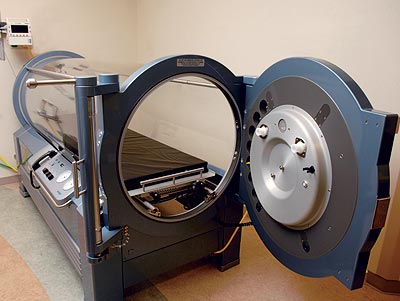During hyperbaric oxygen therapy
Hyperbaric oxygen therapy typically is performed as an outpatient procedure and doesn't require hospitalization. If you're already hospitalized and require hyperbaric oxygen therapy, you'll remain in the hospital for therapy. Or you'll be transported to a hyperbaric oxygen facility that's separate from the hospital.
Depending on the type of medical institution you go to and the reason for treatment, you may receive hyperbaric oxygen therapy in one of two settings:
-
A unit designed for 1 person. In an individual (monoplace) unit, you lie down on a table that slides into a clear plastic tube.
-
A room designed to accommodate several people. In a multiperson hyperbaric oxygen room — which usually looks like a large hospital room — you may sit or lie down. You may receive oxygen through a mask over your face or a lightweight, clear hood placed over your head.
During hyperbaric oxygen therapy, the air pressure in the room is about two to three times normal air pressure. The increased air pressure will create a temporary feeling of fullness in your ears — similar to what you might feel in an airplane or at a high elevation. You can relieve that feeling by yawning or swallowing.
For most conditions, therapy lasts approximately two hours. Members of your health care team will monitor you and the therapy unit throughout your treatment.
After hyperbaric oxygen therapy
You may feel somewhat tired or hungry following your treatment. This doesn't limit normal activities.

